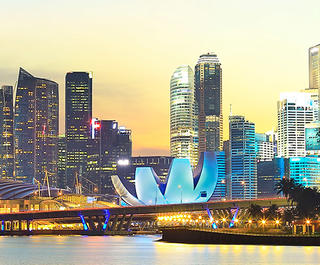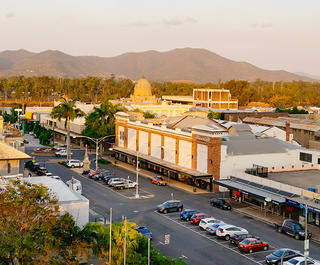
It’s a fresh Saturday morning in Napier, a cheery city on the east coast of New Zealand’s North Island. The sun is bright, a jazz band is playing up a storm and revellers are gathering at the shore.
In front of the immaculately maintained facade of the Art Deco Masonic Hotel, a trio of grey-haired gentlemen in boaters and striped blazers are peering into a seafoam green Studebaker with a sash across its windscreen proclaiming: “I survived the 1931 Hawke’s Bay earthquake.”
Beside the nearby Cenotaph chaps of a similar vintage are queuing for photographs with a troupe of showgirls in fringed hotpants and feather headdresses. A sombre-looking matron in full 1930s regalia lurches, clutching her throat, then pretends her fox stole has come to life – to the delight of shrieking children.
And around the corner, one teenage flapper in a tiny sequined frock and dollar-store pearls is heard telling another: “I’m not myself when I’m dressed up – this is the one time of year my mother can get a photo of me smiling.”
We’re at the art deco weekend to see Napier don its glad rags and celebrate the dazzling architecture that makes it New Zealand’s art deco capital – and one of the world’s best-preserved art deco centres.
Step Back To An Extravaganza Of Elegance
It’s a chance to step back in time for a festival that in its 27th year has become a week-long “extravaganza of elegance”, as its organiser, the city’s Art Deco Trust, puts it.
There are beach banquets, a vintage car parade, aerobatics displays, a “Legends of Cricket” match and a Gatsby picnic among more than 200 events drawing 40,000 visitors to this city of 60,000 and the surrounding Hawke’s Bay region.
It’s a party born of a tragedy: New Zealand’s deadliest natural disaster. That 1931 quake and the fires that followed it razed the town centre, killing at least 256 people. Over the next two years Napier rose from the ashes, rebuilt in the thoroughly modern style of the day.
What emerged is a machine-age jewel of a city, all clean lines, bright whites and pretty pastels beside the cerulean blue of the palm-fringed ocean.
To a deco lover the initial effect is overwhelming: it’s like stepping on to the set of a Miss Marple movie, one in which Agatha Christie’s detective has abandoned St Mary Mead for a sparkling seaside resort. And that’s even without the thousands of extras dressed to the nines who are in town this weekend.
 Festival goers outside the Art Deco Trust Headquarters
Festival goers outside the Art Deco Trust Headquarters
Today most of Napier’s architectural treasures remain – and treasured they are. Especially by the 170 volunteers who work for the trust; staging the art deco weekend, staffing its shop and leading year-round tours.
Growing City's Gift From The Sea
One of them is Cherrie Schollum, who on the Friday – our first full day in Hawke’s Bay – picks us up in what she describes as a “luxury gangster” 1939 Packard for a vintage car tour of Napier’s most impressive buildings. In between regular toots on the horn – “They love it!” she says of the other visitors who are on walking tours through the city centre – she delivers a history lesson.
Hawke’s Bay, she says, was first settled 1,000 years ago by Maori, then in the 1840s by white settlers. But site chosen for Napier, its seaport and administrative centre, was not impressive. Surrounded by the Pacific on one side and marshland and the Ahuriri lagoon on the other, the new town had nowhere to grow.
All that changed at 10.47am on 3 February 1931, when the quake struck some 20 kilometres north-east of Napier. It measured 7.8 on the Richter scale and shook the region for two and a half minutes.
The worst of the damage was done by the blazes that began in chemist shops, where the proximity of bunsen burners to flammable liquids and the gas mains created fireballs.
Yet despite the loss of life and devastation, there was an upside. In contrast to the liquefaction that followed the 2011 earthquake in Christchurch, when the tectonic plates under Napier smashed together they caused an uplift of two metres, draining the lagoon and creating more than 2,000 hectares of land around the town. (Today locals call this their “gift from the sea”.)
 The 1930s neon light at the municipal theatre
The 1930s neon light at the municipal theatre
A month after the quake, the government sent in a magistrate and accountant, John Saxon Barton, and an engineer, Lachlan Bain Campbell, as commissioners charged with rebuilding Napier. They ruled, Cherrie says, as a gang of two “benevolent dictators” and one of their first decrees was to banish all the businesses to a park where a temporary corrugated iron structure dubbed “Tin Town” was erected.
And so, with a clean slate and a distinct lack of red tape, work began. With the Great Depression in full force, there was no shortage of skilled labourers seeking employment; 4,000 of them soon arrived in town.
The city centre was regridded, creating wider roads with rounded corners, and services were buried underground. Building codes were drawn up demanding the use of reinforced concrete.
Want more on the art deco festival? Napier's Charm On Full Display
Make it a family outing. New Zealand: Your Next Family Holiday
Cheap, Strong, Safe Concrete Boxes
As we tour the Napier municipal theatre, listening to the buzzing of its original 1930s neon light, Cherrie describes deco buildings as essentially cheap, strong and safe concrete boxes that have been prettied up, and offers a primer to the styles that inspired the four main architectural firms enlisted to design the new Napier.
One favoured the simple art deco box, another stripped classicism, a third the Spanish mission style that had emerged in California, and the fourth – a local man named Louis Hay – the Chicago-school prairie-style work of Frank Lloyd Wright.
Cherrie, it turns out, is a huge fan of Hay. With an abundance of horn honking she takes us to his masterpiece and the most photographed building in Napier, the tobacco factory he built in 1934 at Port Ahuriri for a German-born tycoon and philanthropist, Gerhard Husheer.
The National Tobacco Company building is simply spectacular; the main entrance features a deco sunburst adorned with art nouveau-style roses. The rose motif is carried through in the elaborately carved wooden doors and the stained-glass dome above the marble foyer.
 The Louis Hay-designed National Tobacco Company building
The Louis Hay-designed National Tobacco Company building
Cherrie also recommends we look in on an example of stripped classicism with a distinctly local flavour, the Auckland Savings Bank that features a frieze with a Māori decoration.
As the Packard delivers us back to the city centre, we’re seeing it with a greater appreciation and understanding. And Napier is filling up fast. As beautiful as the buildings are, it’s the people inside them and thronging the streets who are now claiming our attention.
 Right at home in 1930s style
Right at home in 1930s style
It seems everyone has made an effort to join in the fun. In every shop and cafe, the women have ropes of beads around their necks and feathers in their hair and the men are sporting flat caps and braces. Others, clearly festival veterans from way back, have taken their costumes to another level.
Berated By An Amelia Earhart Clone
One fellow in splendid plus fours and an argyle vest hoists a vintage golfbag. Another wanders near the seashore in a purple striped bathing suit and straw hat.
I’ve just returned from a visit to one of Hawke’s Bay’s famed wineries, with a quick cycling tour thrown in, when an Amelia Earhart clone berates me (extremely nicely) for not being dressed up.
Later I see on Instagram – look for the hashtag #artdecoweekend – that one young woman has posted a composite of her three outfits of the day.
Yet for all the finery of the bright young things, it’s their mothers and grandmothers who steal the show. There’s something particularly flattering about 30s fashion for older women, and this lends authenticity to the outfits their own mothers and grandmothers would have worn.
The superbly organised events cater for all ages but, given the emphasis on tea parties and the music of an earlier era, this is a festival that draws an older crowd. And though thousands of women are wearing the same strings of cheap beads you’d see in New Orleans during Mardi Gras, the atmosphere is far more decorous.
After all, why shouldn’t the Miss Marples of this world have their own music festival?
As the weekend goes on we see bedraggled panhandlers parade through the streets on their way to a depression-era dinner on the site of the old Tin Town, rummage through racks of vintage gowns at an antique fair, join the singalong at a beachcomber ukulele party, and giggle as “Bertie” the MC (real name John Cocking) hosts a bathing belles competition at the outdoor Soundshell.
The Patter Is Only Mildly Inappropriate
His unscripted patter veers into the mildly inappropriate in the most charming way imaginable. The reproduction costumes, he tells us, have nothing to do with measures to increase the population.
The show ends with a mass Charleston lesson led by Nerida Cortese, who with her actor husband Shane (they met 10 years ago on New Zealand’s first series of Dancing with the Stars), is an art deco weekend ambassador.
 Saturday's vintage car parade
Saturday's vintage car parade
But the showpiece events are Saturday’s vintage car parade, featuring 240 of the 400 old vehicles in town – one stalls, requiring a push from the crowd that prompts a huge cheer – and Sunday’s Gatsby picnic in the gardens alongside Napier’s pebbled beach. Elegant gazebos line the pathway; fabulously dressed picnickers play croquet, nibble cucumber sandwiches and sip Earl Grey, G&Ts and bubbles.
Of all the events, this is the one that separates the dabblers from the purists – those aficionados in period costumes from their heads to their impeccably shod toes, who wouldn’t be seen dead clutching a digital camera or a mobile phone.
A few of the best dressed pose for photos with faint smiles and an air of polite condescension.
 Vintage geek Claire Gormly at the Gatsby picnic
Vintage geek Claire Gormly at the Gatsby picnic
One of the in-crowd, self-proclaimed vintage geek Claire Gormly of NZ’s Glory Days Magazine, doesn’t disdain to betray enthusiasm. “The 30s are my favourite era,” she says. “It gets addictive. I’ve got outfits from the 20s to the 60s – my life is a dress-up party.”
Similarly addicted are Geraldine and Gary Waters from Townsville in north Queensland, who are at the art deco weekend for the eighth year in a row. They stumbled on to it by chance during a stop in Hawke’s Bay and have been refining their costumes ever since.
Their only complaint? They just wish even more people could experience the delights of Napier’s huge hootenanny. “Even some New Zealanders haven’t heard of it,” Gary says.
Visit your local Flight Centre store or call 131 600 for more advice and the latest deals on travelling to Napier.
• The Guardian was a guest of Tourism New Zealand and Air New Zealand, now celebrating its 75th birthday. The 28th art deco weekend will run from 18-21 February 2016
This article originally appeared on guardian.co.uk
This article was written by Nikki Marshall from The Guardian and was legally licensed through the NewsCred publisher network.![]()










